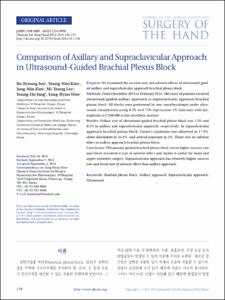KUMEL Repository
1. Journal Papers (연구논문)
1. School of Medicine (의과대학)
Dept. of Preventive Medicine (예방의학)
Comparison of Axillary and Supraclavicular Approach in Ultrasound-Guided Brachial Plexus Block
- Keimyung Author(s)
- Lee, Mi Young
- Department
- Dept. of Preventive Medicine (예방의학)
- Journal Title
- 대한수부외과학회지
- Issued Date
- 2014
- Volume
- 19
- Issue
- 3
- Abstract
- Purpose:
We examined the success rate and adverse effects of ultrasound-guided axillary and supraclavicular approach brachial plexus block.
Methods:
From December 2013 to February 2014, 580 cases of patients received ultrasound-guided axillary approach or supraclavicular approach brachial plexus block. All blocks were performed by one anesthesiologist under ultrasound visualization using 0.2% or 0.75% ropivacaine 1% lidocaine with epinephrine in 1:200,000 as the anesthetic mixture.
Results
:
Failure rate of ultrasound-guided brachial plexus block was 1.2% and 0.2% in axillary and supraclavicular approach, respectively. In supraclavicular approach brachial plexus block, Honer's syndrome was observed in 17.9%, chest discomfort in 14.9%, and arterial puncture in 1%. There was no adverse effect in axillary approach brachial plexus block.
Conclusion:
Ultrasound-guided brachial plexus block serves higher success rate and lower occurrence rate of adverse effect and makes it useful for hand and upper extremity surgery. Supraclavicular approach has relatively higher success rate and lower rate of adverse effect than axillary approach.
- Keimyung Author(s)(Kor)
- 이미영
- Publisher
- School of Medicine
- Citation
- Bo-Byoung Seo et al. (2014). Comparison of Axillary and Supraclavicular Approach in Ultrasound-Guided Brachial Plexus Block. 대한수부외과학회지, 19(3), 130–135. doi: 10.12790/jkssh.2014.19.3.130
- Type
- Article
- ISSN
- 1598-3889
- Appears in Collections:
- 1. School of Medicine (의과대학) > Dept. of Preventive Medicine (예방의학)
- 파일 목록
-
-
Download
 oak-aaa-2486.pdf
기타 데이터 / 210.61 kB / Adobe PDF
oak-aaa-2486.pdf
기타 데이터 / 210.61 kB / Adobe PDF
-
Items in Repository are protected by copyright, with all rights reserved, unless otherwise indicated.